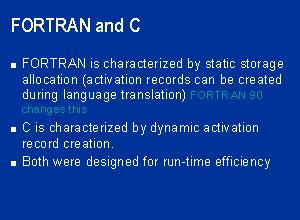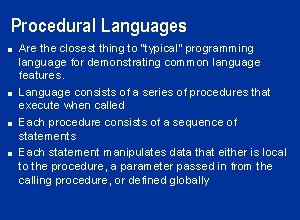



CS441-Programming
Languages: Design Implementation
Due:
November 17, 2003
Authors: |
Email Addresses: |
Desiree Shaw |
|
LaAisha
Ettress
|
|
Amanda
Oropeza
|
A blocked structure procedural language called Algol was developed in the mid 1960’s. In 1971 Nicklaus Wirth developed a language called Pascal. Pascal was developed as a successor of Algol. Pascal language was known for the ability to grow and shrink during runtime and the ability to define new data types. Pascal was taught in classrooms because of its great portable compilers and was even used as the official language of the Advanced Placement test. Pascal is no longer used.
Dennis
Ritchie developed a simple procedural language called C in 1972.
C had a lot of power because it could be used to re-write Unix assembly
language. C was also used in many
classrooms, but like most languages, it is no longer used.
Both
languages were taught in classrooms. Both
languages are not as popular as they use to be.
Pascal is no being used because a better language came, alone which was
C, and C, is no longer used because of C++.
The block structure was mainly designed to be a teaching tool. The information is considered to be readable and typically easier for a person to understand. The block structure language Pascal uses algorithms to express what the program is doing. The compiler is designed to diagnose an incopability of any type to a variable of another type.
The best representative of Block Structured Procedural languages is Pascal. Pascal is a strongly typed language. Most of the languages in the block structured procedural languages are strong typed. Integers, reals, characters, enumerations, Booleans, arrays, records and pointer types are data types used by block structured procedural languages. Block structured procedural allows the programmer to develop new types, but does not provide grouping and encapsulation with a set of subprograms for operating on new type data objects. Simple procedural languages also use the same data types as block structured procedural languages like variables, ints, Booleans and etc. Simple procedural language statements manipulate data that either is local to the procedure, a parameter passed in from the calling procedure, or defined globally.
a.
Subprograms
Block structure program Pascal has subprograms called procedures. Procedures communicate with the main program. The main problem with Pascal is that you cannot write a subprogram that takes an array of variable length as a parameter.
With simple procedural language the code can be called any where within the program, but generally do not allow recursion.
b.
Storage Management
Block structural language Pascal there is no storage class and it must be visible and unique in a large scope.
Simple procedural has four main areas where storage management is kept and they are:
i. Global/Static
ii. Stack/Local
iii. Heap/Dynamic
iv. Registers/Temporary
Each of these can be executed during read-write of
the memory page.
Neither block structured procedural languages nor simple procedural languages handle abstraction and encapsulation as well as other language families. Simple procedural languages programs must be able to locally access all aspects of the program. Block languages can declare internal local procedures and create a full nested name hierarchy of data objects.
C++ is an object-base language and was named in 1983 and developed by Bjarne Stroustrup at Bell Labs during 1983-1985. C++ is a re-designment of C. C++ has all of the features of C but also has new features, functions, and operator overloading. C++ was developed for the Unix environment.
Dennis
Ritchie developed a simple procedural language called C in 1972.
C had a lot of power because it could be used to re-write Unix assembly
language. C was also used in many
classrooms, but like most languages, it is no longer used.
C
language has been dominated by C++ that is being taught in classrooms today.
Both languages use algorithms that are designed to resemble the English
language.
C++ was implemented in 1984; its ancestor is the C language. When C++ was developed it provided things that C did not such as, collection of predefined classes, inheritance, virtual classes, and over loading among other things.
Simple procedural languages such as Assembler are considered to be easier to read also. It uses symbolic code, and its flexibility comes from being able to read high and low level languages. Simple procedural languages are generally used for development in different products such as computer games, automobiles, and telecommunication equipment…. Both languages are considered to be easy to read.
Object Based languages
contain the same data types as simple procedural like integers, variables,
Booleans and etc. However unlike simple procedural object-based languages also
have objects, classes, subclasses, and other advanced data types that allow the
language to function globally instead of just locally like simple procedural.
Object based languages
have classes. These classes have inheritance properties. There can be a single
or multiple inheritances. A single inheritance contains a subclass, which has
one super class. Java is an example of a single inheritance. Multiple
inheritances have a subclass with more than one super class. C++ is an example.
Object based languages operate by having a parameter or function called. The
language will run the function when it receives the instructions on how to run
the function. The instructions for a function are contained in a class
definition. The definition specifies the properties of an function. It includes
instructions on how to execute the function and variables for the function.
Simple procedural goes by a first defined first run procedure.
c.
Subprograms
Object-based subprograms in C++ have functions whose parameters are checked, they have to be declared before they can be used (called).
d.
Storage Management
Object-based storage management with C++ is not that great because of the ability to allow memory leakage.
Simple procedural has four main areas where storage management is kept and they are:
i. Global/Static
ii. Stack/Local
iii. Heap/Dynamic
iv. Registers/Temporary
Each of these can be executed during read-write of the memory page.
Object based
languages handle abstraction and encapsulation very well. Object based languages
are able to control certain aspects of the language. The language employs the
use of public and private class and function names.
Object oriented uses private capabilities to ensure certain definitions
and executions are not shown to the outside code.
Private variables are shared by all instances of a defined class. Global
variables are shared by all instances of all defined classes. Simple procedural
languages only access locally.
FORTRAN
is an example of a simple procedural language, and was the first high-level
language. Developed in 1954 by John Backus at IBM and designed for use on their
IBM 704 systems, released in 1957. All versions, including the latest, FORTRAN
95, were designed as “Formula Translators”. The idea was to emulate
mathematical formulae in coding so that scientific applications could be written
in a language that looked like math, and could be translated into machine
language. Other examples include B, C, ALGOL and PL/I.
Logic
Based programming languages came later, in the 1970’s. Of these languages,
Prolog, after “Programming Logic”, was developed in France and England at
the University of Aix-Marseille by Colmerauer and Rousselat, and at the
University of Edinburgh by Kowalski. Here the plan was to develop a language
that emulated predicate calculus. Applications include database management and
Artificial Intelligence, and are limited in scope.

FORTRAN
was remarkably efficient, and until its release, programmers did not believe
that a high level language could be as efficient as hand coding. The three
aspects: high level, compiled, and efficiency changed programming forever. All
storage is allocated statically before program execution begins. Other Simple
procedural languages share these characteristics, and other attributes.
Simple
procedural languages feature a main program, and subprograms. Instructions are
sequenced, and executed in order. They share block structure, recursion, and
parameter passing by value and name. In this chart are some other
characteristics of Procedural Languages.

Logic based programs are a stark contrast. Specific problems are solved using the truth or falsehood of the processes, rather than the computed value. This has been likened to using the logical components of the CPU, versus the arithmetic components. This strategy makes for very difficult and inefficient programming, but is well suited for applications in artificial intelligence that depend on decision making. Applications also include database management, expert systems, and processing of natural languages, again, where decision-making is more logic focused than mathematically computed.
Procedural
languages have a variety of data types, as opposed to relatively few in
logic-based languages. In Simple Procedural languages there are: integers, real,
complex, Boolean, logical, character, strings, void, just to name a few.
In Logic Based there are less than Procedural which are: variables,
atoms, and numbers.
Simple
procedural languages have built in functions, usually in libraries, and a host
of structures. Logic based languages have predicates, rules, and use databases
to relate facts with each other. Structures are limited.
Simple
procedural languages were written with sequence control. They follow “Order of
Operations” similar to rules for sequencing. Linear thinking was a design
prerogative. Statements to aid this control are logical loops, CASE, DO and
IF-THEN-ELSE. Goto and recursion are also supported, as well as built in
function call & return.
Logic
based languages use non-arithmetic expression forms, arithmetic expressions,
pattern matching and back tracking to handle sequence control. CUT in Prolog is
somewhat analogous to GOTO. A main feature of Prolog is the use of pattern
matching to determine if a query is solved by a fact in the database or if the
fact can be deduced using the rules in the database applied to other facts or
rules.
Sub
programming is a vital part of the design of simple procedural languages. Subprograms have the feel of
mathematical functions and can be nested, operated upon and composed. Pass by
reference, name of value are built in. Libraries are provided with built in
mathematical functions, and programmer defined functions are allowed. Static and
dynamic memory allocation is allowed.
Logic
based languages also allow dynamic memory allocation, but the similarity ends
there. Sub programming is difficult, but may be included as function, which
returns true or false.
Abstract
data types are not supported directly in simple procedural languages, and not
supported at all in logic based languages. The use of modularization emulates
abstraction and encapsulation. Simple procedural type languages emulate
encapsulation with the use of subprograms. However, this method provides for
poor encapsulation constructs. Prolog uses modules to implement encapsulation
and abstraction.
|
Authors: |
Language
Type: |
Web
Addresses: |
|
Ahmad
Ibrawish, Afrazuddin Mohannad, Neal
Bellamy, Nghi
Phan. |
Simple
Procedural |
http://a.students.umkc.edu/atic9f, http://a.students.umkc.edu/azm150, http://n.students.umkc.edu/nlb477/index.html, http://p.students.umkc.edu/phann/. |
|
Brian
Buckly, Ryan Johnson, Prasad Natoo, Lisa
Presson |
Block
Structre, Procedural |
|
|
Andrew
Lee, Lei
Zhu, Nancy
Schneider, Sepideh
Dehghani, Trung Nguyen |
Object
- Bases |
|
Concepts
of Programming Languages, Fifth Edition Sebesta, Robert W.
Addison-Wesley
Publishing Company, Inc. 1999
http://www-4.ibm.com/software/ad/pli/about.htm
http://www.cs.bsu.edu/homepages/dmz/cs335/ppt/fortran_c/ppframe.htm
http://www.cs.bsu.edu/homepages/dmz/cs335/ppt/pascal/ppframe.htm